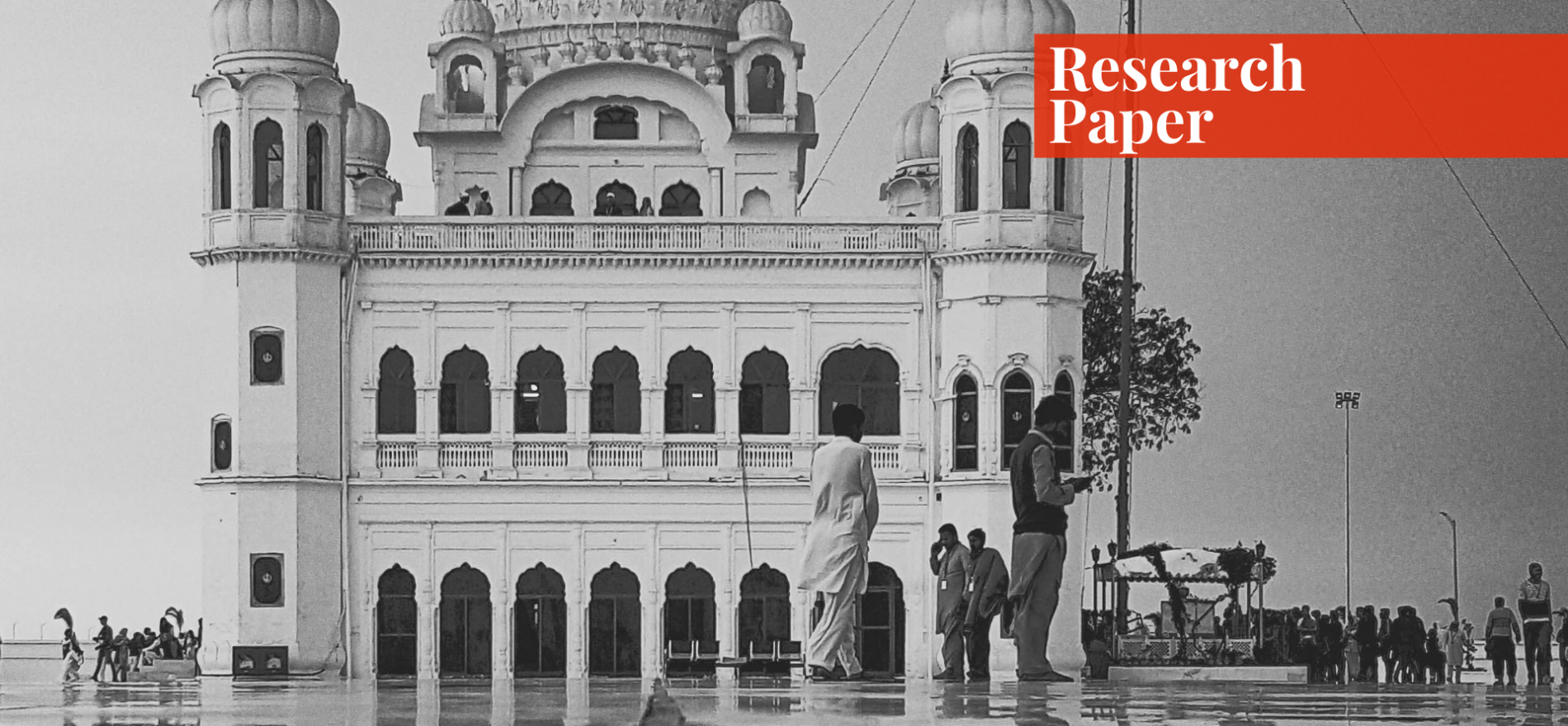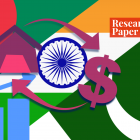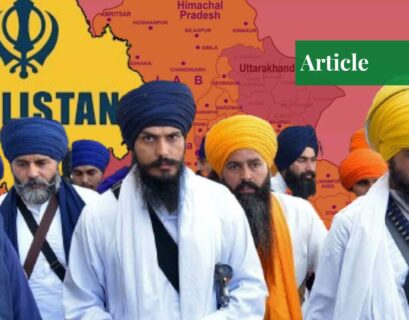Mr Shayan Asees is currently pursuing a Bachelor's in Political Science from LUMS.
Introduction
Long-distance nationalism tends to explain why certain communities residing outside their previous homeland stay emotionally attached to it while living in the host-land. Why is it that a young Sikh living in the UK or Canada wants to promote the Khalistan movement in order to see Indian Punjab as a separate entity? The phenomenon of nationalism portrayed by the distanced community is fascinating.
The author discusses the role of the Sikh diaspora in the Khalistan movement through a theoretical lens of long-distance nationalism. According to Harpreet Kaur (2009, p.1087), the first-ever demand for Khalistan was made by Jagjit Singh Chauhan, a former finance minister of Punjab, in North America in 1971.
He issued an advertisement in the New York Times which said, “The world has been oblivious of the fate of 12 million Sikhs living under the political domination of India and in fear of constant genocide. Another 6 million of us living in alienation and waiting for our day of deliverance…we are a religious, ethnic, and cultural entity distinct from Hindus who rule India. We are a nation in our own right. We are a people with a sense of history. A people with a dream who have endured persecution and endless sufferings at the hands of an intolerant mercenary majority that rules India – The Hindus. We shall suffer no more” (New York Times, 1971).
What is Diaspora?
Addressing this question is one of the difficult tasks in the field of political science. Different political scientists tend to explain the term from different perspectives. William Safran (1991, p. 83-84) gave six features to define the diaspora groups: dispersed groups from an original centre to at least two peripheral places; that maintain a memory or myth about their homeland; that believe they are not fully accepted by their host country; that see the ancestral homeland as a place of return when the time is right; that is committed to the maintenance, safety, and prosperity of the homeland; and that have group consciousness and solidarity.
The Sikh diaspora community tends to check all the boxes: they are dispersed groups residing in Britain, Canada, and even the United States away from Punjab; they maintain the connection with their ancestral homeland Punjab through practicing similar traditions in the host state; the Sikh community blames Indian Hindus for violating their human rights and a right to have a separate state.
Moreover, Khalistan literature tends to give hope for a separate homeland hence motivating for the struggle and the Sikh community tends to give financial aid to the Sikh community back in India. There is also a strong group consciousness promoted through institutions like Gurdwaras. According to Safran, the diaspora community tends to emerge from exile or traumatic experience, while many authors disagree.
Safran’s approach does not include the migrant community that did not face any traumatic or exiled situation but still share similar sentiments with the fellow ethnic community. Baubock says, “groups whose migration was not traumatic and coerced may eventually mobilize as diasporas in response to trouble in the homeland” (Baser, 2016, p. 18).
At the time of British India, many Sikh men were a part of the British army and sent to the West for military operations. Many settled down after independence and started their families. They did not go through any traumatic experience as compared to the Sikhs who fled from India after the anti-Sikh riots. Nonetheless, they all still share the same sentimental values regarding Khalistan. Hence, the phenomenon of diaspora formation is not historical but circumstantial.
Diasporic Turn for Sikhs
Now if we were to say that the phenomenon of the diaspora is circumstantial, what makes it circumstantial? Safran (2007) suggests that “diaspora consciousness may be revived after a special event, such as a revolutionary struggle or a tragic experience that brings back the importance of the kinship connection”.
In the case of the Sikh diaspora, the most prominent event that ignited Sikh nationalism across borders was “Operation Blue Star”, which was carried out by the orders of Indra Gandhi in 1984. Indra Gandhi ordered the military troops to enter the Golden Temple in Amritsar and kill the Sikh leader Sant Jarnail Singh Bhindranwale along with many Sikhs.
Indra Gandhi’s Sikh bodyguards avenged their brothers’ deaths by killing her. The preceding events gave rise to riots in India, and homes and business sites belonging to the Sikh community were demolished with more than 2000 Sikhs losing their lives. The communal riots against the Sikh community were systematically carried out by the ruling Congress party.
The incident sent huge shockwaves across the borders, among overseas Sikh communities. The actions carried out against the Sikh community were taken as a sign of war against Sikh culture. “The homepages of both Burning Punjab and Khalistan.com, two of the most popular sites, explicitly refer to state repression of Sikhs in India, which they claim has resulted in the deaths of a quarter of a million people in the last two decades, by the term genocide” (Shani, 2008, p. 94).
According to Colonel Partap Singh Ajrawat, Operation Blue Star was a “massive act of state terrorism whose ‘sole purpose’ was to reduce Sikhs to servility” (Shani, 2008, p.24). Hence the violence against Sikhs in India portrayed Hindu Indians as the sole enemy of the Sikh community. The second traumatic incident that gave the Sikh community living overseas the diasporic turn, was the violence against Sikhs during the independence of British India.
The world experienced one of the biggest migrations in history on the division of the subcontinent into Pakistan and India. The Muslims from east India heavily migrated to the west Muslim dominated region that emerged as Pakistan. Muslims in Rawalpindi forced the religious minorities predominantly Hindus and Sikhs to leave the regions and migrate to the other side of the border.
The process of ethnic cleansing carried out by Muslim League gave rise to nationalist discourse that was both Indian and Sikh in nature. Although the Khalistan literature portrays the Sikh as the victims of the communal violence, certain sources suggest that Sikhs were involved in the ethnic cleansing of Muslims as well.
According to Shani (2008, p. 88), “although Sikhs played an active role in ‘cleansing’ East Punjabi villages of Muslims, the nationalist discourse portrays the Sikhs exclusively as victims rather than participants in this ‘ethnic cleansing’.” The need for a separate state emerged in the 1940s when the Sikh political leaders realized that Muslim and Hindu states were about to establish.
To secure their separate land, the political leaders started calling Punjab their ancestral and rightful homeland. “Oberoi contends that this territorialization was formalized in March 1946 when the executive committee of the Sikh political party, the Shiromani Akali Dal, passed a resolution proclaiming the natural association of the Punjab and the Sikh religious community” (Fair, 2005, p. 130).
Hence, the demand for a separate state, the land of pure, emerged when the Sikh political elites realized that Pakistan and India are ready to make it to the world map; the demand was rather modern than historical.
Sikh Diaspora Organizations
Every ethnic community looks for getting political representation to voice their opinions and so some form political parties and venture for democratic peaceful means, while others choose the violent path. Lobbying refers to “influencing the government and its leaders in an attempt to sway policy-makers and legislators to address specific issues, often by introducing or revising legislation and policy” (Baser, 2016, p.34).
The political leaders operating these organizations tend to make partners sharing similar sentiments for having strong collective influence. Haney and Vanderbush (1999) argue that organizational strength, the permeability of and access to the government, salience and resonance of the message of the diaspora group, and voter participation are highly important for the effectiveness of lobby activities (Baser, 2016, p.34).
If the diaspora organizations are successful in having political influence in the host state, they can use that influence to capitalize on their movement. Most of the Sikh diaspora organizations arose after Operation Bluestar, but the first-ever demand for Khalistan was made in 1971. The Babbar Khalsa International (BKI) is one of those violent organizations formed in Canada by Talwinder Singh Parmar and Sukhdev Singh Babbar.
Later, the Babbar Khalsa (Parmar) faction emerged in 1992 after Talwinder’s disagreement with the BKI leadership. The BKI believes in fighting for the creation of Khalistan, the land of pure. BKI has been labeled as a terrorist organization by India and the United States.
The Canadian government, as reported by Harpreet Kaur (2009, p.1088), described BKI in the following words: “Babbar Khalsa (BK) and Babbar Khalsa International (BKI) are entities of a Sikh terrorist organization whose aim is to establish a fundamentalist, Independent Sikh state called Khalistan (Land of the pure) in the area that is presently the Indian state of Punjab. BK and BKI continue to be one of the most vicious and powerful militant Sikh groups”.
In 1984, after Operation Bluestar, another violent Sikh diaspora organization was found in the UK with the name of the International Sikh Youth Federation (ISYF), formed by Amrik Singh and Jasbir Singh Rode. The ISYF was proscribed in India under the Prevention of Terrorism Act (POTA) in 2002 (Kaur, 2009, p.1088).
Both organizations, the BKI and ISYF, have been involved in various criminal activities in Canada, the United States, the UK, etcetera and have been banned in the respective states. However, there are certain Sikh diaspora organizations that believe in non-violent political struggle. Although the approach of these organizations is non-militant, they both share the same agenda, the rise of Khalistan.
After Operation Bluestar, the World Sikh Organization (WSO) was formed by 2500 Sikhs in New York, USA. According to Harpreet Kaur (2009, p.1089-1090), Didar Singh Bains, Retired Major General J.S Bhullar, and Ganga Singh Dhillon were the main leaders of the organization; it constituted 30 members, one-third from the United States, Canada, and Great Britain.
It fought for various issues like the right to wear a turban. The organization promoted universal brotherhood, freedom of worship, peace, etcetera. CBC accused WSO of having ties with Sikh terrorist organizations, but WSO sued CBS for over $100 million for their report (Kaur, 2009, p.1090).
Another nonviolent Sikh diaspora organization is the Council of Khalistan. Its name gives out a clear message, the struggle to liberate the land of pure. The organization was headed by Dr. Gurmit Singh Aulakh, he proved out to be a great lobbyist with a healthy number of seats in the House of Representatives protesting (peacefully) against India’s human rights violations. There is another Sikh diaspora organization like Khalistan Affairs Center in the list of nonviolent peaceful Sikh organizations.
The Importance of Gurdwaras
According to Bahar Baser (2016, p.39), the diaspora groups import shared narratives, myths, and rituals into the host country to promote the narrative. Certain institutions are responsible for reproducing the narratives; in the case of the Sikh diaspora, they are Gurdwaras. Gurdwaras hold political, religious, and cultural importance for the Sikh community worldwide.
It has been used to raise funds for the Khalistan movement, to mobilize the Sikh diaspora for the movement through the depiction of the Sikhs’ warlike history and their struggle for a separate state. As C.C. Fair (2005, p.8), suggests that the halls and rooms of the gurdwaras have photos of martyrs from the Punjab conflict along with the historical martyrs from the ancient Sikh history; this establishes a common line between the Sikh oppression from the 17th century to the modern period.
Host vs Home State Dilemma
According to Bahar Baser (2016, p.27), diaspora nationalism is also dependent on the relations between the host and the homeland. If they are in a conflict, the host country can capitalize on the situation to destroy the rival state, or to gain the political support of the diaspora community for votes.
Both Indian and Pakistan would never let go of any opportunity to capitalize on each other’s internal conflicts. India has been allegedly involved in supporting Anti-Pakistan Baloch Liberation Army (BLA) and has been openly trying to defame Pakistan over the Pashtun and Baloch crisis.
As reported by C.C Fair (2005, p.133), many Indian Sikhs travel to Pakistan for pilgrimage, and during their stay in Pakistan for the pilgrimage, the Sikh community is provided with Khalistan literature from the diaspora groups. This kind of access to such material could not have been possible in India.
Conclusion
In the end, I would conclude that the rise of the Sikh diaspora and their attachment with the Khalistan movement started with a traumatic incident like Operation Bluestar. As discussed previously, the Sikh community overseas found the operation an attempt to erase the Sikh community from its bases. They claimed it was a genocide or “the second holocaust”.
Although the Sikh diaspora is still very much compassionate about Khalistan, I think that the trend has declined over the years. One of the possible reasons could be that the Sikh diaspora, whose ancestors migrated to the host country, tend to accept their new home. Not every Sikh would want to go back to Punjab, since they have made their own Punjab in host countries.
A huge number of Sikhs living abroad have created a sense of unity in their own small sub-society within host countries by engaging in traditional & religious practices. Hence, I conclude that the rise of nationalism in the Sikh diaspora community, was not to have a separatist agenda, but out of sympathy for the victims of Punjab violence and Operation Bluestar.
Bibliography
- Baser, Bahar. (2016). Diasporas and Homeland Conflicts: A Comparative Perspective. New York: Routledge. p.18-39.
- Fair. C. Christine. (2005). ‘DIASPORA INVOLVEMENT IN INSURGENCIES: INSIGHTS FROM KHALISTAN AND TAMIL EELAM MOVEMENTS,’ Routledge, pp. 125-126, https://doi.org/10.1080/13537110590927845.
- Kaur, Harpreet. “DIASPORIC SIKH ORGANISATIONS.” The Indian Journal of Political Science, 70(4), 2009, pp. 1085–1098, www.jstor.org/stable/42744021.
- Safran, W. (1991). Diasporas in Modern Societies: Myths of Homeland and Return. Diaspora: A Journal of Transnational Studies 1(1), 83-99. doi:10.1353/dsp.1991.0004.
- Safran, W. (2007). Concepts, theories, and challenges of diaspora: A panoptic approach, Prepared for presentation at the workshop on “Dispersione, globalizzazione e costruzione dell’alterità: Diaspore et migrazioni nel bacino del Mediterraneo et oltre (xix-xx secc.)”, sponsored by University of Pisa, Department of History. Marsala, Italy.
- Shani, Giorgio. (2008). Sikh Nationalism and Identity in a Global Age. New York: Routledge. p.24,94.
If you want to submit your articles and/or research papers, please check the Submissions page.
The views and opinions expressed in this article/paper are the author’s own and do not necessarily reflect the editorial position of Paradigm Shift.


















